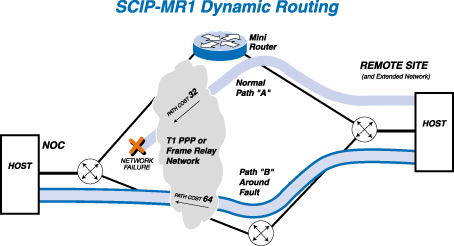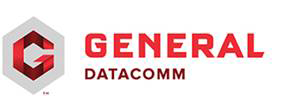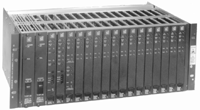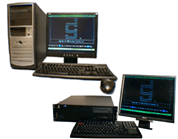|
|
|

 Enterprises with geographically distributed operations depend on wide area networks (WANs) to control mission critical operations. A staple of remote office WAN infrastructure, integrated access channel banks such as the Xedge1000 from General DataComm, do more for less. Some think that all channel banks perform the same. Think again. The modular Xedge1000 from General DataComm provides a hybrid network solution that addresses critical cost saving issues such as:
The flexible Xedge1000 also interoperates with the Xedge 6000 flagship multiservice switch. In particular the DS1/E1 WAN interface of the Xedge1000 communicates with the Voice Service Module (VSM) of the Xedge 6000 that can transport and groom the voice and data traffic through a switched network. Already used in networks around the world, the Xedge1000 is installed in utilities, government organizations, and transportation entities.
Data Sheets
|
- Category: Products
| |
|

|
- Category: Products
|
|
|

OCM-1000/2000-Office Communications Manager The OCM-1000 and OCM-2000 are powerful, cost-effective TDM networking platforms. The OCM-1000 provides point-to-point and point-to-multipoint connectivity to small and medium sized branch sites. The OCM-2000 extends the TMS-3000 backbone network's capabilities to remote branch office locations. Both OCM platforms offer connectivity to a variety of digital carrier services, allowing users to select the one with the best performance/cost ratio in each location. They use the same bandwidth optimization techniques as the TMS-3000 to efficiently transport voice and data traffic. OCM Highlights
Network Management The P.C. based GDC TMS Software (GTS) application provides network configuration, control and management to TMS-3000, OCM-2000 and MiniMux nodes. In point-to-point and point-to-multipoint OCM-1000 networks, the P.C. based OCM Management System (OMS)can be utilized. Both systems provide configuration, alarm reporting, diagnostics and centralized system management. Simple , pop-up windows and mouse or keyboard commands make GTS and OMS user-friendly, while providing comprehensive functionality. New GTS 5.x Platform GDC's new release, GTS 5.x is a Pentium 4 based platform that is backward compatible and supports all the option cards and modules associated with previous TMS software version GTS 2.2. In addition, GTS 5.x supports LAN connectivity for Telnet and LAN-based logins and provides SNMP alarm traps.
 Enterprises with geographically distributed operations depend on wide area networks (WANs) to control mission critical operations. A staple of remote office WAN infrastructure, integrated access channel banks such as the Xedge1000 from General DataComm, do more for less. Some think that all channel banks perform the same. Think again. The modular Xedge1000 from General DataComm provides a hybrid network solution that addresses critical cost saving issues such as:
The flexible Xedge1000 also interoperates with the Xedge 6000 flagship multiservice switch. In particular the DS1/E1 WAN interface of the Xedge1000 communicates with the Voice Service Module (VSM) of the Xedge 6000 that can transport and groom the voice and data traffic through a switched network. Already used in networks around the world, the Xedge1000 is installed in utilities, government organizations, and transportation entities.
Data Sheets
Application Briefs Customer Profiles
|
- Category: Products
| |
|

Carrier Grade Dynamic Routing with RIP and OSPF The SpectraComm IP Mini Router (SCIP-MR1-T1) blade extends the users IP networks to remote locations where routed IP networks are required. SCIP-MR provides connectivity via an integral T1 WAN port, and provides full dynamic routing capability with support for standard RIP and OSPF protocols. Enhanced security is supported with secure shell (SSH) and MD5 authenticated dynamic routing at a fraction of the cost of typical solutions and uses less than 6 watts of power. TACACS+ authentication is also supported. Network maintenance is streamlined with SCIP-MR1-T1 automatically adapting to changing network topologies and rerouting traffic around faults.  The SCIP-MR1-T1 is a rack-mount blade that can be installed in existing NEBS Level 3 certified SpectraComm 5000 shelf (16 slot) or 2000 (2 slot) shelf. For CPE applications the single slot SpectraComm 1001 or 1002 enclosures are available. Remote SCIP-MRs can be managed via IP connection and SMART CLI, an interactive command line interface that will feel familiar to field personnel. Added features include auto-prompting for command arguments, recognition of abbreviated commands, online help and command line recall. SCIP-MR-T1 also supports firmware download and configuration download/restoral via TFTP. Features Include:
Carrier Grade Dynamic Routing with RIP and OSPF Like the SpectraComm MR1-T1 above, The SpectraComm MR1-E1 blade extends the users IP networks to remote locations where routed IP networks are required. SCIP-MR1-E1 provides connectivity via an integral E1 WAN port, and provides full dynamic routing capability with support for standard RIP and OSPF protocols. Enhanced security is supported with secure shell (SSH) and MD5 authenticated dynamic routing at a fraction of the cost of typical solutions and uses less than 6 watts of power. TACACS+ authentication is also supported. Network maintenance is streamlined with SCIP-MR1-E1 automatically adapting to changing network topologies and rerouting traffic around faults. SpectraComm IP Ethernet Extension A powerful technology is now available from General DataComm to help Carriers reduce costs while expanding their internal IP networks, increasing revenues and providing a high margin IP service offering. SCIP LAN-X extends the reach of IP connectivity with value-added features and benefits:
As Carriers and PTTs expand and provision the use of equipment in their networks, the 100-meter distance limitation of standard Ethernet can become an issue. By extending the LAN over longer distances, the network architecture can be simplified and the need for expensive routers is eliminated. GDC's SCIP LAN-X offers out-of-band management solutions for LAN-attached IP devices over standard FT1/T1, E1/FE1, DDS or xDSL circuits. LAN extension between floors or between buildings uses the available digital technology for timely installation and management of services over existing facilities. This same technology can be used to offer transparent LAN services (TLS) to customers as a new TLS service offering. SpectraComm IP & SpectraComm IP E1
As Carriers introduce IP equipment to their networks, GDC offers two access solutions for LAN-attached IP devices and legacy (Craft Port) devices. Either mode of operation can be conducted over the Carrier's T1/FT1, E1/FE1 or DDS network, as well as over a dial-up PSTN.
When additional NEBS-compliant Ethernet connectivity is required, SC-IP can integrate with SpectraComm Ethernet Switch (SC-ES) cards, offering scalable IP connectivity in 9 or 18 port increments.
SpectraComm IP G.shdsl.bis allows Ethernet connectivity beyond the 100-meter distance limitation without the need for expensive routers. LAN extension can be accomplished with GDC's SCIP G.shdsl.bis which transports data on copper loops at rates up to 5.632 Mbps on a single loop or 11.264 Mbps on 2-loops for LAN-attached IP devices. LAN extension between floors or between buildings using DSL technology allows timely installation and management of services over existing facilities. SCIP G.shdsl.bis delivers a reliable Ethernet extension solution for use in first mile, symmetrical, Ethernet deployments. In the event of a loop failure, SCIP-G,shdsl.bis in 4-wire mode performs auto-fallback to single loop operation, and two-loop restoral when the failed loop recovers. Auto-fallback and Auto-restoral functions are individually enabled/disabled. Each SCIP G.shdsl.bis unit comes equipped with two 10/100 Base-T ports and eight terminal server ports for connection to customer equipment, and is fully managed. For applications that require scalable Ethernet connections, the SpectraComm Ethernet Switch, (SCES) companion product can be deployed in 9- or 18-port increments.
The SpectraComm Ethernet Switch provides fast ethernet connectivity for internal networks, allowing a Carrier to efficiently and securely manage LAN-attached equipment. As part of the GDC SpectraComm family of products, SpectraComm Ethernet Switches offer the high reliability and NEBS safety required in Carrier environments. SC-ES can be deployed as a replacement to legacy hubs or in new installations where fast ethernet switching is desired. SpectraComm ADT The SpectraComm ADT (Asynch Data Transfer) allows Carriers and Enterprise Users to support and manage remote equipment that traditionally would require direct craft port connecton. This is accomplished by encapsulationg the asynchronous traffic and transporting the information via a secure and safe Ethernet as if it were a LAN-based application. Users can now access any craft port device on the LAN via telnet. In cases were direct LAN access is not available, connectivity can be provided via a dial-up connection using SpectraComm ADTs'integral modems. A convenient telnet menu allows device delection by description field or port number. SpectraComm ADT also provides support for telemetry and security applications. Each SpectraComm ADT device provides up to eight contact input ports for sensing activation of an open or closed contact; and up to two contact output ports to open and close a local contact relay. SpectraComm ADT detects a contact change from its normal state and, depending on its congfiguration, will send an alarm trap, transport the contact state, or perform both trap and transport actions. A "clear" trap is sent when the contact returns to the normal state. The SpectraComm SDT (SC-SDT) allows the transport of synchronous data traffic via standards based Ethernet. This is accomplished by encapsulating the synchronous traffic and transporting the information as if it were a LAN-based application. SpectraComm SDT supports three individually configurable ports and a single Ethernet uplink. Each synchronous data port is configurable for rates from 2400bps to 2.048 Mbps. For applications over distances beyond the limitations of Ethernet, the SpectraComm SDT can be attached to any existing router for transport via the Wide Area Network (WAN) to the desired location. For new installations, GDCs SpectraComm IP family of routers can provide WAN connectivity using T1/FT1, E1/FE1 or G.SHDSL SpectraComm SDT also provides support for telemetry and security applications. Each SpectraComm SDT device provides up to eight contact input ports for sensing activation of an open or closed contact; and up to two contact output ports to open or close a local contact relay. SpectraComm SDT detects a contact change from its normal state and, depending on its configuration, will send an alarm trap, transport the contact state, or perform both trap and transport actions. A clear trap is sent when the contact returns to the normal state. The DataComm Blade Adapter allows you to use GDCs newest products without having to invest in additional shelves and provides new networking options. Beyond the legacy DataComm products that were supported by the DataComm series shelves, you will now be able to utilize existing DataComm shelves for SpectraComm and InnovX products that are direct replacements with all the features of the older DataComm series. In addition, you will be able to install GDCs new line of IP Routers, Ethernet switches and asynchronous and synchronous serial data-to-Ethernet adapters. Every new single blade product can be supported in the same shelf. As DataComm slots are used up, transition to the newer SpectraComm and InnovX platforms is simple with no compatibility or sparing issues. Because the DataComm Adapter is compatible with all single blade line-by-line devices from both GDCs flagship SpectraComm Carrier family and the InnovX Enterprise family of products, existing DataComm shelves can now support an expanded range of applications that include; DDS, FT1, T1, T3, DSL, IP/Ethernet along with modems. Data Sheets |
- Category: Products
| |
 Modem Security Radius, Steadfast AES Encryption
Network security is a high priority for any enterprise and information network that stores or provides access to critical assets. General DataComms SpectraComm family of systems and network devices support SteadFast Modem Security solutions that protect your network assets from attacks by illegal users and malicious hackers. GDC systems and products are designed with rigorous security solutions that meet the requirements of mission-critical network applications, such as service provisioning, banking and financial communication, transportation and governmental agencies. GDCs proven telco-tough SpectraComm SteadFast solutions give network administrators a suite of protection options for their large or small network environments,including Security, Authentication, Encryption and Disaster Recovery. SteadFast Modem Security solutions protect network assets by blocking disruption of service due to data theft, data corruption, illegal intrusions, shutdowns, line failure and component failure. RADIUS Security for Legacy Applications
To answer many of the Internet's security needs, a new standard of authentication was required. Remote Authentication Dial In User Service (RADIUS) brought a client-server architecture to ISPs, enabling efficient, secure authentication of dial-in users. RADIUS manages a database of users, provides authentication so that the dial-in user is allowed access, and delivers configuration information detailing the type of service to provide to the user -- such as SLIP, PPP, telnet, etc. GDC's SpectraComm Manager (SCM), Dual V.34 and single SpectraComm V.34 modems' management support RADIUS Security. The V.34 modems prompt the user for name and password and forward this information to the RADIUS server. The RADIUS server authenticates the user and returns a message to the modem to grant or deny access. Optionally, the RADIUS server may challenge the remote user and request additional information before granting access. Steadfast Security®
GDC modems offer "hacker" protection through our SteadFast Security®. This exclusive system delivers two levels of first line security:
AES Encryption AES Encryption employs the Advanced Encryption Standard which is a symmetric 128-bit block data encryption technique. AES Encryption takes plain-text data and encrypts it according to the AES algorithm to generate cipher-text data. AES is an approved FIPS-197 U.S. Government encryption standard.SpectraComm VF 28.8, Dual V.34, V.34 and V.34 4-Port modems support the AES (Rijndael) encryption standard. The user configures the modem for AES Encryption by entering an encryption key via AT commands at one of the modems management interfaces Telnet connection through the SCM, the SCM craft port, or the modems DTE interface). AES Encryption allows each modem to take transmit/receive asynchronous data and encrypt/decrypt it on a dial-up or private line network. Secure Access Controller The Secure Access Controller (SAC) system employs a factory- optioned GDC V.34 modem to authenticate remote users attempting to access protected network equipment, such as switches, routers, multiplexers, etc. and then AES Encrypts data once the user is authenticated. SpectraComm V.34 and Dual V.34 modems support the Secure Access feature. The modem is user-configured via extended AT commands typed at one of the modems management interfaces (Telnet via the SCM, the SCM craft port, or a terminal connected to the modems DTE connector). Click on the chart to view Modem Product Literature List |
||||||||||
- Category: Products
- Category: Products





